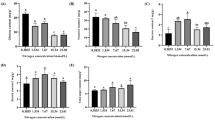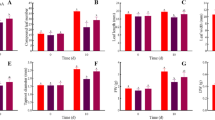Summary
Changes in tissue contents of some free amino acidscharacteristic of the glutamate and aspartate pathways in tomato plants following increase in the concentration of nitrate or ammonium in the nutrient solution have been studied.
An increase in ammonium produced a massive accumulation of glutamine both in the roots and in the shoot. Asparagine lagged behind and accumulated to a much smaller extent than glutamine. Glutamic acid and proline decreased with increased ammonium whilst aspartic acid and threonine concentrations were less affected. re]19750318
Similar content being viewed by others
References
Bassham, J. A., The control of photosynthetic carbon metabolism. Science 172, 526–534 (1971).
Cocking, E. C. and Yemm, E. W., Synthesis of amino acids and proteins in barley seedlings. New Phytologist 60, 103–116 (1961).
Coic, Y., Le Saint, C. and Le Roux, F., Effects de la nature ammoniacale ou nitrique de l'alimentation sur le metabolisme des anions et cations chez la tomate. Ann. Veg. 4, 117–125 (1962).
Dijkshoorn, W., Metabolic regulation of the alkaline effect of nitrate utilization in plants. Nature 194, 165–167 (1962).
Dijkshoorn, W., The relation of growth to the chief ionic constituents of the plant. In Ecological Aspects of the mineral Nutrition of Plants. British Ecolog. Soc. Symp. No 9 edited by Rorison, I. H. Blackwell Scient. Publ. Oxford and Edinburgh 1969.
Ebertsjr., F. S., Burris, R. H. and Riker, A. J., The metabolism of nitrogenous compounds by sunflower crown gall tissue cultures. Plant Physiol. 29, 1–10 (1951).
Holzer, H. and Witt, I., Beschleunigung des oxidativen Pentosephosphatcyclus in Hefezellen durch Ammoniumsalze. Biochim. Biophys. Acta 38, 163–164 (1960).
Jungk, A., Wechselwirkungen zwischen Stickstoffkonzentration (NH4, NH4NO3, NO3) und pH der Nährlösung auf Wuchs und Ionenhaushalt von Tomaten. Garten bauwissen. 35, 14–28 (1970).
Katsunna, N., Okada, M. and Nishii, Y., Regulation of the urea and TCA cycle by ammonia. Advances in Enzyme Regulation 4, 317–335 (1966).
Krogmann, D. W., Jagendorf, A. T. and Avron, M., Uncouplers of spinach chloroplast photosynthetic phosphorylation. Plant Physiol. 34, 272–277 (1959).
Lorenz, H., Zwei Programme auf Lithiumcitrat- und Natrium-Lithiumcitratbasis für die Analyse der freien Aminosäuren in Pflanzenmaterial. Phytochem. 10, 63–66 (1971).
Lorenz, H., Freie Aminosäuren in Blättern ingezüchteter Landsorten und in Hybridsorten von Mais. Phytochem. 11, 139–151 (1972).
Mac Vicar, R. and Burris, R. H., Studies on nitrogen metabolism in tomato with use of isotopically labelled ammoniumsulphate. J. Biol. Chemistry 176, 511–516 (1948).
Matsumoto, H., Wakiuchi, N., and Takahashi, E., Changes in starch synthetase activity of cucumber leaves during ammonia toxicity. Physiol. Plantarum 24, 102–105 (1971).
Pate, J. S., Wallace, W. and vanDie, J.. Petiole bleeding sap in the examination of the circulation of nitrogenous substances in plants. Nature 204, 1073–1074 (1964).
Sims, A. P. and Folkes, B. F., A kinetic study of the assimilation of (15N) ammonia and the synthesis of amino acids in an exponentially growing culture of Candida utilis. Proc. Royal Soc. B159, 479–502 (1964).
Wakiuchi, N., Matsumoto, H. and Takahashi, E., Changes of some enzyme activities of cucumber during ammonia toxicity. Physiol. Plantarum 24, 248–253 (1971).
Wallace, W. and Pate, J. S., Nitrate assimilation in higher plants with special reference to the cocklebur (Xanthium pennsylvanicum Wallr.). Ann. Botany 31, 213–228 (1967).
Author information
Authors and Affiliations
Additional information
Institut für Pflanzenernährung der T.U. Hannover
Rights and permissions
About this article
Cite this article
Lorenz, H. Free amino acids in tomato plants in relation to form and concentration of nitrogen in the rooting medium. Plant Soil 45, 163–168 (1976). https://doi.org/10.1007/BF00011138
Received:
Published:
Issue Date:
DOI: https://doi.org/10.1007/BF00011138




